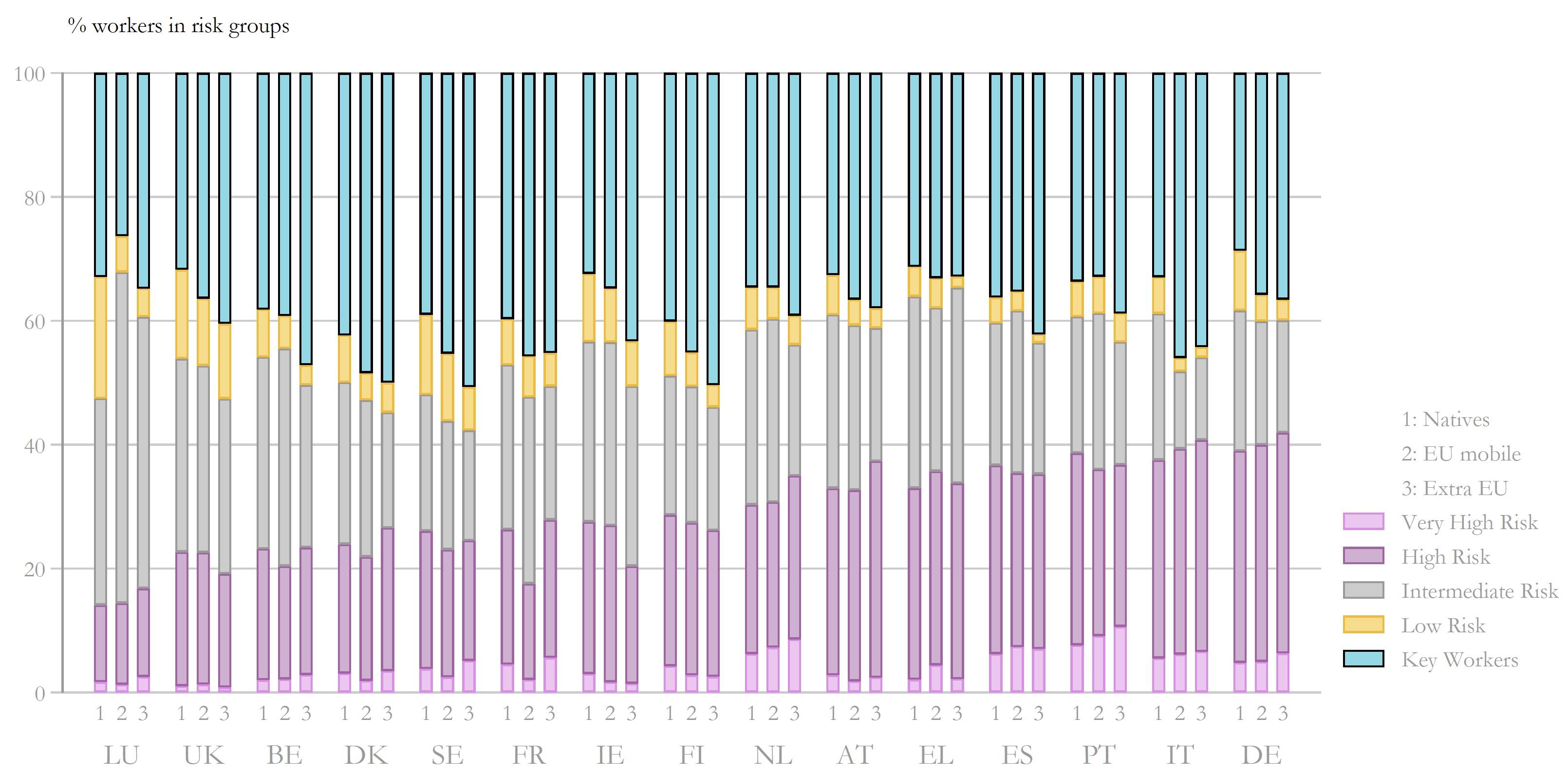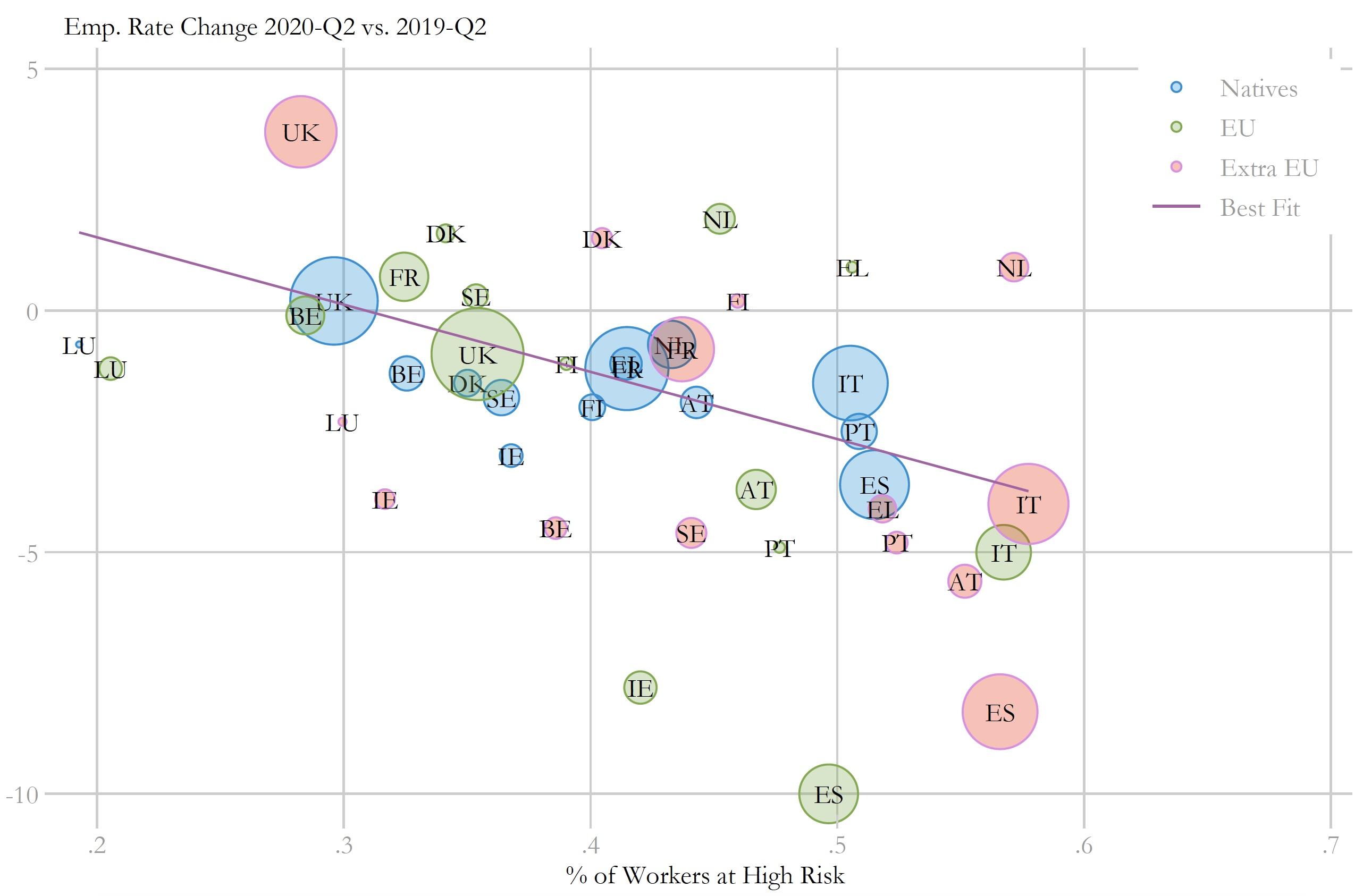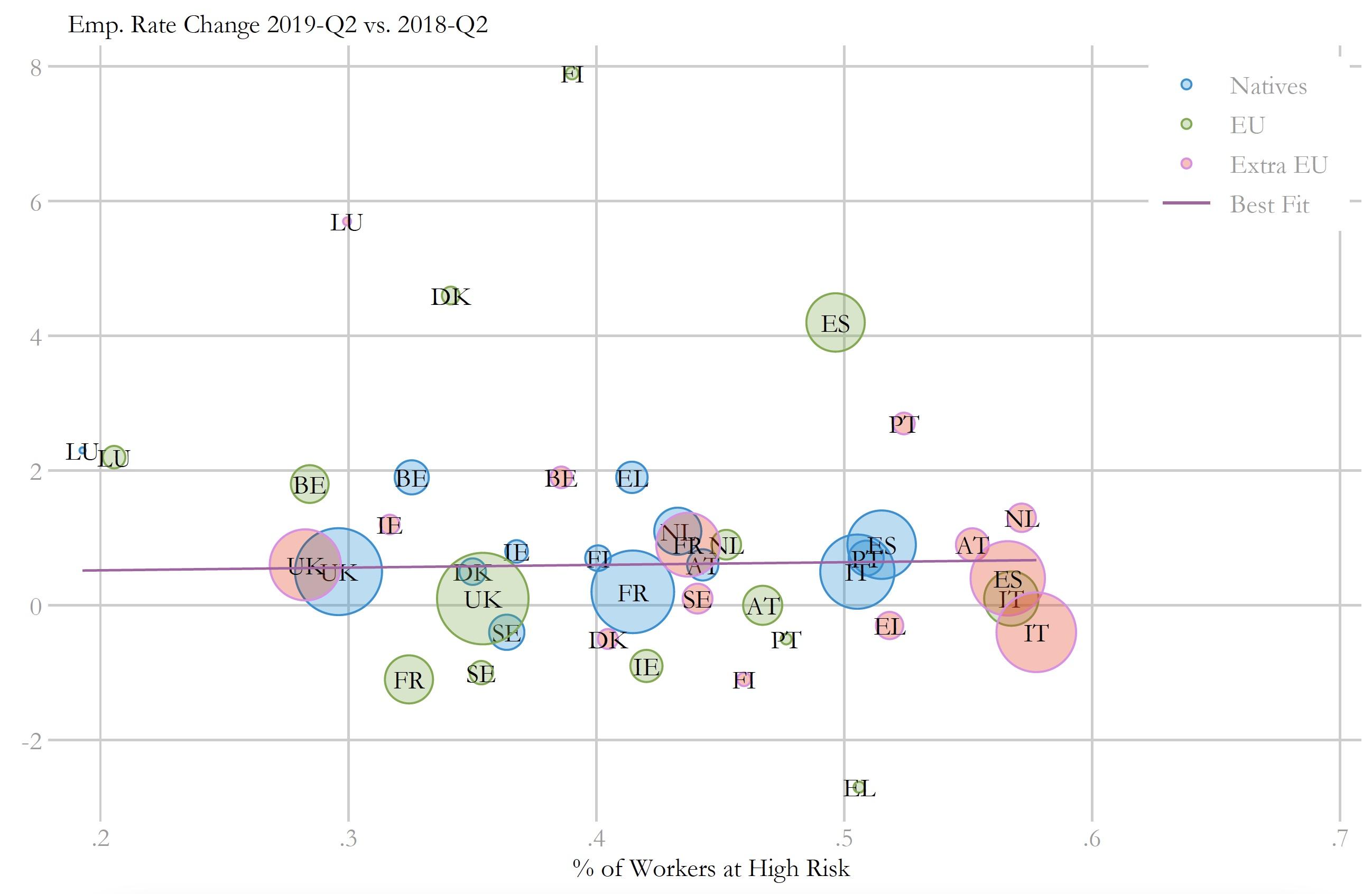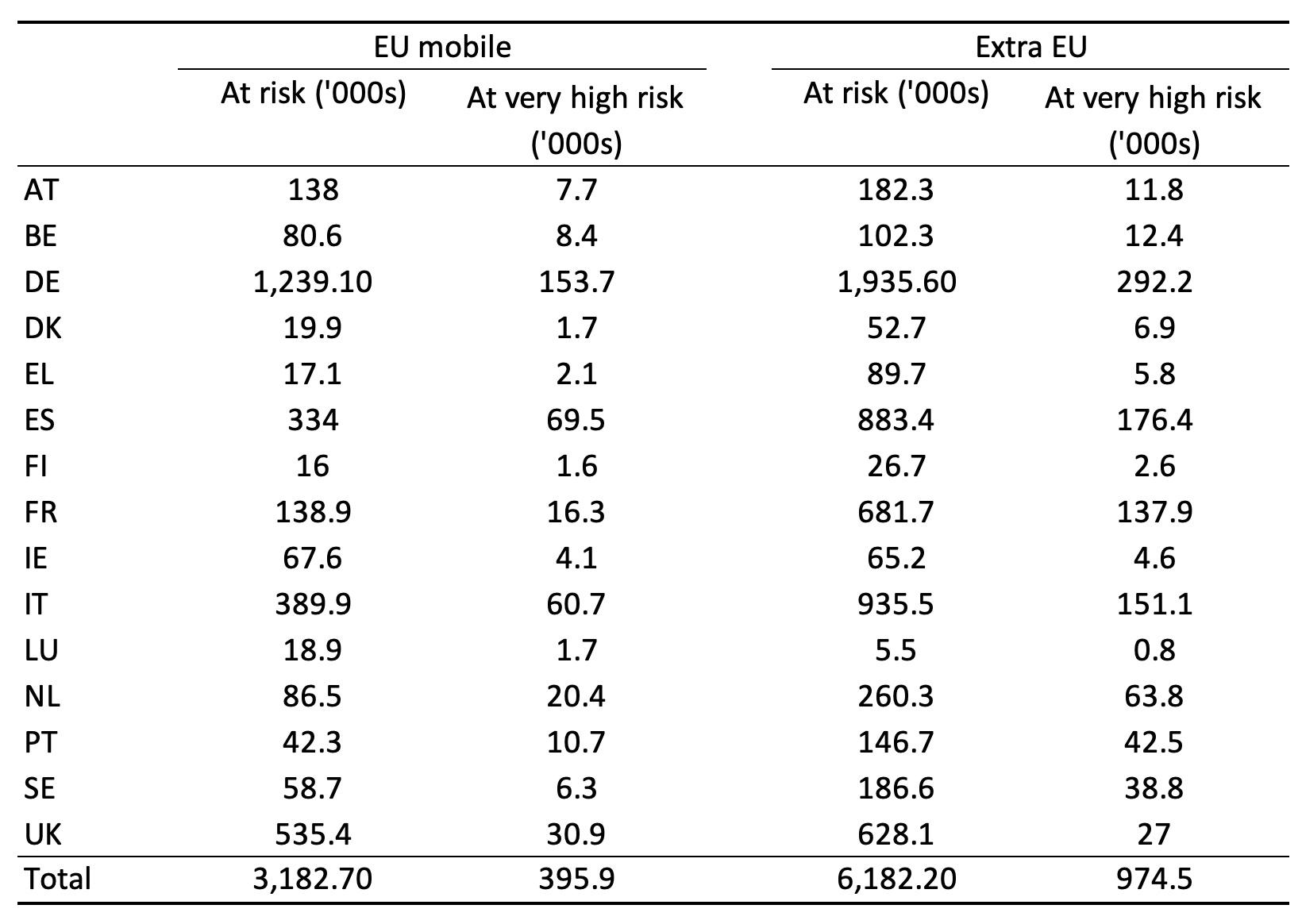By mid-December 2020, more than 65 million people globally had been infected by COVID-19 and more than 1.5 million had died from it. The human cost of the pandemic is dramatic. Its economic cost is also huge. Global GDP contracted by 10% in the first half of 2020. Over the first half of 2020, major European countries experienced drops in both output and private consumption of up to 20% (OECD 2020). Europe has been hit particularly hard by the two waves of the pandemic. Facing the prospect of seeing their health system overwhelmed, most European governments had few policy options available and resorted to partial or total lockdowns of their economies. These measures played an important role in curbing the spread of the virus, but the costs exacted in terms of employment losses on European economies are still to be quantified, as are their distributional impacts.
Early evidence on the impact of lockdown measures during the first coronavirus outbreak has unveiled the unequal labour market consequences of individuals with different socio-demographic characteristics. Pandemic-induced job losses were concentrated among low-wage industries and occupations, young workers, the low educated, women, and ethnic minorities (Adams-Prassl et al. 2020, Cortes and Forsythe 2020, Couch et al. 2020, Hapiku and Petrongolo 2020, Basso et al. 2020).
Immigrant workers are particularly vulnerable. As relative new entrants in the labour market who typically face linguistic and institutional barriers to access occupations, migrants are generally more likely to have non-standard or informal contract, shorter job tenure, and lower-skilled occupations than comparable natives. The combination of all these factors makes their employment status particularly sensitive to business cycle fluctuations, increasing their vulnerability during economic downturns. Some evidence on severe decline in employment due to the pandemics for this group of workers is coming from the US (Borjas and Cassidy 2020), but how migrant workers are weathering this storm in Europe is not known yet.
Migrant workers in the wake of the pandemic
In a recent paper (Fasani and Mazza 2020), we propose a novel measure aiming at capturing the exposure to employment risk of workers, and migrant workers specifically, in the EU14+UK area. Our measure is based on four characteristics of workers’ occupations that have become pivotal in predicting their potential vulnerability in the current COVID-19 crisis: (1) essentiality, (2) temporariness, (3) teleworkability, and (4) industry resilience.
First, we account for the distinction between essential and non-essential occupations that many governments introduced when imposing lockdown measures. We find that 42% of extra-EU migrant workers and 38% of EU mobile workers are essential compared to 35% of natives. Workers employed in key sectors and occupations could generally continue their activities. The recognised importance of their functions has thus shielded their jobs from labour market contractions induced by social distancing measures and the ongoing recession, while potentially heightening their social interactions and thus their risk of contagion. The second dimension that we consider is the duration of employment contracts. Having lower firing costs than workers on permanent contracts, fixed-term workers are the first ones to be laid off when negative shocks hit the firm or the sector (Blanchard and Landier 2002) independently of the origin of the economic downturn. The third factor that we analyse is the degree of teleworkability of occupations, which has been rapidly identified as one the most important predictors of job loss in the COVID-19 crisis (Adams-Prassl 2020, Dingel and Neiman 2020, Mongey et al. 2020). Last, we factor in the additional uncertainty associated to differential exposure to the pandemic crisis across industries. Following Pagano et al. (2020), we characterise industries as resilient to the crisis or not based on the degree of teamwork, interaction with customers, and physical presence required by the occupations in each industry. According to this definition, industries whose occupations require high levels of interaction with colleagues and customers and of physical presence are less resilient to the social distancing measures and are expected to suffer more and for longer.
Expecting key workers to be exposed to a substantial lower risk of unemployment, we treat them as a separate category. We then assign non-essential workers to four categories of employment risk: (1) very high, (2) high, (3) moderate, and (4) low. In our definition, non-essential workers at very high risk are those vulnerable along all the other three dimensions we have identified (i.e. being on a temporary contract, in a non-teleworkable job, and low-resilience industry). We then define workers to be at high risk if their job is not essential and if at least two out of the other three conditions are satisfied. Finally, we distinguish the remaining non-essential workers into intermediate risk (i.e. vulnerable on one other dimension) and low risk (i.e. not vulnerable on any other dimension).
As Figure 1 attests, the share of ‘workers at risk’ fluctuates widely across European countries, being around 20% of all employed workers in Luxembourg, the UK, France and Denmark, while approaching (and even exceeding) 40% in Austria, Portugal, Spain, Germany and Italy. As we discuss in the paper, variation across countries – as well across national groups within the same country – are determined by the concentration of workers in occupations with attributes that expose them to layoff risk. Countries with large shares of workers at risk tend to have relatively lower shares of essential workers, a larger share of employees with fixed term contracts, a smaller share of teleworkable occupations, and a relatively low presence of resilient industries.
Figure 1 Share of workers in risk groups, by host country and origin
Note: The countries are ordered according to the sum of the shares of workers at very high and high risk.
To assess how well our composite indicator captures the dynamics of the European labour markets observed in the months immediately following the first pandemic outbreak, in panel (a) of Figure 2, we plot the change in employment rates by origin – native, EU, and extra-EU migrants – between the second quarters of 2019 and 2020 (vertical axis) against the percentage of workers in the high risk group in each country and for each nationality. The countries and nationalities for which we predicted the largest shares of workers at high risk of job loss are in fact those who experienced the sharpest drop in employment during the first wave of the pandemic. When we regress our measure on the observed employment rate change between 2019 and 2020, our estimated coefficient is significant at the 1% level and the R2 of this simple regression is around 0.5. To further test our measure, in panel (b) of Figure 2, we replicate the same chart but we now look at employment changes between 2018 and 2019, hence before the pandemic started. The lack of predictive power of our measure – clearly highlighted by the flat line in the figure – confirms that it is able to capture the peculiar labour market dynamics induced by the pandemic without being mechanically correlated to long run labour market performances in the countries analysed.
Figure 2 Risk measure versus employment rate change in Q2 2020
a) Post-pandemic (Q2 2020 - Q2 2019)
b) Pre-pandemic (Q2 2019 - Q2 2018)
Note: The figure reports scatter plots of changes in employment rate (vertical axis) against the percentage of workers in the high/very high risk group (horizontal axis) disaggregated by host country and origin group (native, EU mobile and Extra-EU migrants). Changes in employment rate are computed between the second quarters of 2019 and of 2020 in panel (a) and between the second quarters of 2018 and of 2019 in panel (b). Markers' area is proportional to country's population aged 16 to 65 for each nationality.
Migrant workers at risk in Europe
Based on our measure of employment risk, we calculate that approximately 3.1 million EU mobile workers in EU14+UK countries are at risk of becoming unemployed due to the pandemic, accounting for 31% of the 10.2 million employed workers in the region. Among these workers at risk, 395 thousand face a very high risk of being laid off. As far as extra-EU migrants are concerned, more than 6.1 million workers may become unemployed due to the pandemic, 32.7% of the 18.9 million individuals employed in EU14+UK countries. Almost a million of them (974 thousand) fall in the very high risk category. These figures point at a total population or more than 9 million foreign born workers – slightly less than one third of their total employment in the EU14+UK area – that are employed in jobs and sectors that may be severely affected by the pandemic-induced crisis. For more than 1.3 million of them the risk is extremely high. Remarkably, this latter figure is very close to the drop in employment of migrant workers recorded during the first wave of the pandemic (which is approximately 1.1 million fewer employed workers).
Table 1 Employed workers at risk, by host country and migrant group
Note: The table reports the number of employed workers at risk (i.e. exposed to high or very high risk) and the number of employed workers at very high risk for EU mobile (left panel) and Extra Eu workers (right panel), and for each host country in the EU14+UK area.
Conclusions
The employment consequences of the pandemic and the ensuing lockdowns on workers, and migrant workers in particular, are potentially enormous and our analysis quantifies them. For this group of workers, job termination can have severe consequences. Jobless migrants might be forced to return to their country of origin lest they fall into irregularity. Of particular concern are also the detrimental repercussions on migrants’ origin areas, which are often heavily reliant on remittances inflows. Policymakers need to pay particular attention to this group of workers. Not only migrants' welfare is at stake here, but it is also in the interest of hosting societies to create the conditions for migrant workers to keep contributing to the solution of the ongoing crisis as they have done so far, and to the future recovery.
References
Adams-Prassl, A, T Boneva, M Golin and C Rauh (2020), “The large and unequal impact of COVID-19 on workers”, VoxEU.org, 8 April.
Basso, G, T Boeri, A Caiumi and M Paccagnella (2020), “The new hazardous jobs and worker reallocation”, OECD.
Blanchard, O and A Landier (2002), “The Perverse Effects of Partial Labour Market Re-form: Fixed-Term Contracts in France”, The Economic Journal 112(480): F214–F244.
Borjas, G J and H Cassidy (2020), “The Adverse Effect of the COVID-19 Labor Market Shock on Immigrant Employment”, NBER Working Paper 27243, May.
Cortes, G M and E Forsythe (2020), “Impacts of the covid-19 pandemic and the cares act on earnings and inequality”, IZA Discussion Paper No. 13643.
Couch, K A, R W Fairlie, and H Xu (2020), “Early evidence of the impacts of covid-19 on minority unemployment”, Journal of Public Economics.
Dingel, J and B Neimann (2020), “How many jobs can be done at home?”, VoxEu.org, 7 April.
Fasani, F and J Mazza (2020), "Being on the Frontline? Immigrant Workers in Europe and the COVID-19 Pandemic," IZA Discussion Papers 13963.
Hupkau, C and B Petrongolo (2020), “COVID-19 and gender gaps: Latest evidence and lessons from the UK”, VoxEU.org, 22 April.
Mongey, S, L Pilossoph and A Weinberg (2020), “Which workers bear the burden of social distancing policies?”, NBER Working Paper 27085.
Pagano M, C Wagner and J Zechner (2020), “COVID-19, asset prices, and the Great Reallocation”, VoxEU.org, 11 June.
OECD (2020) OECD Economic Outlook, Interim Report September.







